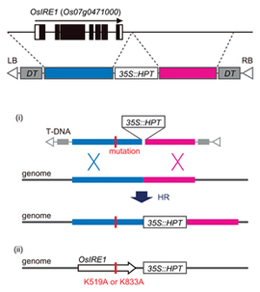Research Abstract
イネの遺伝子ターゲティングで明らかになった小胞体ストレスセンサーIRE1が有する複数の機能
Multiple roles of the ER stress sensor IRE1 demonstrated by gene targeting in rice
2012年12月10日 Scientific Reports 2 : 944 doi: 10.1038/srep00944

小胞体(ER)ストレスセンサーIRE1にはキナーゼドメインとリボヌクレアーゼドメインが含まれる。このうちリボヌクレアーゼ活性は、シロイヌナズナではAtbZIP60、イネではOsbZIP50という転写因子をコードするmRNAの特殊なスプライシングにかかわり、これにより、ERストレスに応答するためのシグナルを伝達している。本論文では、遺伝子組換え型イネを用いて、植物IRE1の上記以外の機能を明らかにする。相同組換えを利用した遺伝子ターゲティングを行い、ゲノム上のIRE1を、IRE1のキナーゼ活性もしくはリボヌクレアーゼ活性を欠損させた2種類のミスセンスアレルに置換した。これらのアレルについての遺伝学的解析を行うことで、IRE1のキナーゼ活性が、リボヌクレアーゼ活性とは無関係な、細胞の生命維持に不可欠な役割を果たしていることを明らかにした。さらに、OsbZIP50 mRNA 以外のリボヌクレアーゼの基質の存在を初めて示した。本研究は、高等植物のシグナル伝達についての新たな知見を、遺伝子ターゲッティングを駆使して得た例となる。
若佐 雄也1*, 林 晋平1*, 小沢 憲二郎1 & 高岩 文雄1
- 独立行政法人 農業生物資源研究所 遺伝子組換え研究センター
*本研究は、若佐 雄也、林 晋平の2研究者が同等に貢献した成果として論文発表しています。
The endoplasmic reticulum (ER) stress sensor, IRE1, contains a kinase domain and a ribonuclease domain. Ribonuclease mediates the unconventional splicing of mRNA encoding the transcription factor AtbZIP60 in Arabidopsis, or OsbZIP50 in rice, and thereby transduces signals from stressed ER. Here, we demonstrate the additional roles of plant IRE1 using genetically modified rice plants. Using a gene targeting system based on homologous recombination, genomic IRE1 was replaced with two types of missense alleles, leading to a defect in the kinase or ribonuclease activity of IRE1. Genetic analysis of these alleles demonstrated that the kinase activity of IRE1 plays a vital role independent of ribonuclease activity. Furthermore, the existence of ribonuclease substrates other than OsbZIP50 mRNA is demonstrated for the first time. This study provides new insights into higher plant signalling using a gene targeting approach.

